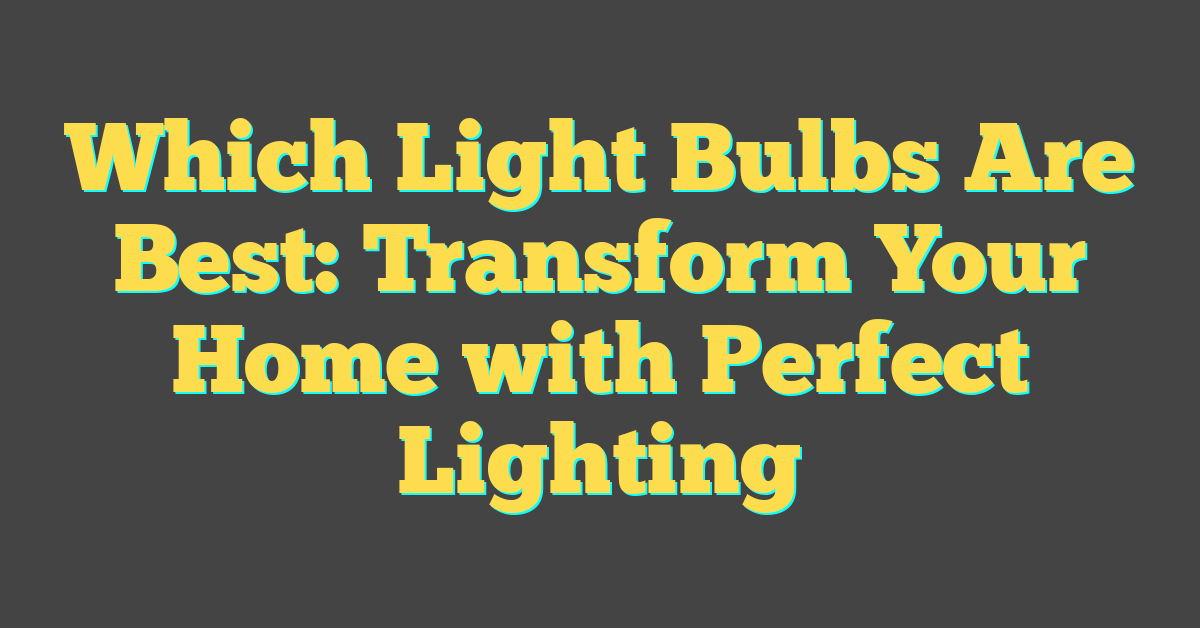Choosing the right light bulb can feel like a quiz on wattage, lumens, and color temperature. But don’t worry, you’re not alone in the quest to brighten your space efficiently. It’s about finding that sweet spot where functionality meets your personal style.

With so many options on the market, from energy-saving LEDs to the warm glow of incandescents, picking the best bulb is more than just a shot in the dark. Let’s shed some light on the subject and help you illuminate your home like a pro.
Understanding Wattage and Lumens
Knowing the difference between wattage and lumens is essential when you’re picking out the perfect light bulb for your home. Wattage refers to the amount of energy a bulb uses, while lumens measure the amount of light the bulb emits. In the past, you likely chose bulbs based on wattage, thinking higher watts meant more light. But that’s not quite how it works.
Here’s a helpful breakdown:
| Watts (Incandescent) | Lumens |
|---|---|
| 40W | About 450 lumens |
| 60W | About 800 lumens |
| 75W | About 1,100 lumens |
| 100W | About 1,600 lumens |
Today’s bulbs, including LEDs and CFLs, use far less energy for the same brightness, making lumens a more accurate measure of how bright your bulb will be. For instance, a 10-watt LED bulb can produce the same number of lumens as a 60-watt incandescent bulb. That’s energy efficiency at its best!
Adding to that, understanding color temperature is another layer to your lighting choice. Measured in Kelvins, this scale indicates the hue of the light your bulb emits. Lower numbers mean a warm, yellowish glow—ideal for cozy living spaces—while higher numbers produce a cooler, bluer light, perfect for task lighting in spaces like kitchens and home offices.
Armed with your knowledge of wattage, lumens, and color temperature, you’re well on your way to choosing light bulbs that not only shine bright but also cater to the ambiance you’re aiming for. Remember, it’s not just about the bulb’s energy consumption but also about its light output and the feel you want to create. Whether you’re looking for clarity in your study nook or warmth in your reading corner, there’s a world of bulbs out there ready to meet your needs. Keep in mind the space and purpose—your perfect bulb is just around the corner.
Comparing Different Types of Light Bulbs

When you’re on the hunt for the perfect light bulb, you’ll encounter a variety of options—each with their own strengths and ideal usages. Incandescent bulbs are the traditional choice and offer a warm, inviting glow that’s perfect for cozy, ambient setups. However, they’re not as energy-efficient as their modern counterparts.
Compact Fluorescent Lamps (CFLs) are a popular energy-saving option. They require less wattage for the same luminous output as incandescents but take a bit of time to warm up to full brightness. Because they contain a small amount of mercury, you’ll need to handle them with care and recycle properly.
Light Emitting Diodes (LEDs) are the frontrunners in energy efficiency and longevity. Unlike CFLs, LEDs reach full brightness instantly and often last for thousands of hours longer. Plus, they come in a range of color temperatures, allowing for precise ambiance control.
For those of you who love a good DIY project, LEDs offer fantastic flexibility. They are adaptable for smart home systems, allowing you to adjust brightness and color with just a tap on your smartphone. This feature can transform your space and even enhance your mood. Imagine switching from a high, cool Kelvin temperature for focus during a project, to a lower, warmer one for relaxing afterwards—all without changing the actual bulb.
It’s also essential to consider the CRI (Color Rendering Index) when comparing bulbs. A higher CRI means colors appear more accurate and vibrant under the light. This is especially important in areas where you’re completing tasks that require precise color differentiation, like sewing or painting.
Below is a comparison of the key features of these bulb types:
| Feature | Incandescent | CFL | LED |
|---|---|---|---|
| Energy Use | High | Medium | Low |
| Lifespan | Short | Moderate | Long |
| Brightness | Good | Good | Excellent |
| Color Temp | Warm | Varies | Varies |
| CRI | Moderate | Good | Excellent |
| Instant On | Yes | No | Yes |
| Dimmable | Yes | Some models | Yes |
| Mercury | No | Yes | No |
Energy-Saving LEDs: The Top Choice

« What Do Light Bulbs Work? Unlock the Future of Lighting Innovation
Can You Paint Light Bulbs? Unlock Creative Home Decor Ideas »
When you’re knee-deep in your next home DIY project, considering the perfect lighting can make all the difference. LEDs, or Light Emitting Diodes, are your best bet for several compelling reasons. Not only do they slash your electricity bill, but they also boast a lifespan that incandescent bulbs can’t hold a candle to.
Let’s shine a light on their energy efficiency. LEDs use about 75% less energy than traditional incandescent bulbs. This isn’t just good news for your wallet; it’s also a step forward in reducing your carbon footprint. The longevity of LEDs is nothing short of impressive. An LED bulb can last between 25,000 to 50,000 hours. That’s years of use before you’ll even need to think about replacing them.
Here’s a quick comparison between LED and incandescent bulb lifespans:
| Bulb Type | Average Lifespan (Hours) |
|---|---|
| LED | 25,000 – 50,000 |
| Incandescent | 1,000 – 2,000 |
Aside from their lifespan and efficiency, LEDs excel in versatility. These bulbs fit seamlessly into any corner of your smart home system. Fancy a dim, amber-hued lounge for movie night? Or bright, invigorating white light in your home office? You can customize LEDs to a T, all with a few taps on your smartphone or voice commands.
Even in extreme temperatures, LEDs perform reliably. They’re ideal for outdoor lighting or in spaces like your garage, where temperatures can fluctuate wildly. Unlike CFLs, they don’t contain mercury; this makes them an eco-friendly choice that’s easier to dispose of.
Given their incomparable energy savings, longevity, and customizability, LEDs stand out as the top choice. Integrating them into your home lighting plan isn’t just a savvy move—it’s an investment in a brighter, more sustainable future.
Incandescent Bulbs: The Warm and Traditional Option

While you’re exploring the world of lighting, it’s hard to ignore the classic charm of incandescent bulbs. They’ve graced our homes for over a century, providing a warm, inviting glow that’s synonymous with comfort. Their familiar radiance is often associated with nostalgia, giving a space that cozy feel you just don’t get with other types of lighting.
Though they may not be the champions of energy efficiency, incandescent bulbs still have their unique advantages:
- Immediate Illumination: Unlike some energy-saving bulbs that take a moment to warm up, incandescents light up instantly.
- Color Rendering Index (CRI): They have a perfect CRI of 100, meaning they show the true colors of your space.
- Cost: They are often cheaper upfront compared to their more efficient counterparts.
Here’s a quick snapshot of how much energy traditional incandescent bulbs use compared to LEDs:
| Bulb Type | Average Lifespan | Energy Usage |
|---|---|---|
| Incandescent | 1,000 to 2,000 hours | 60 watts |
| LED | 25,000 to 50,000 hours | 8-12 watts |
Keep in mind though, while incandescent bulbs are less expensive when you hit the store, they’ll cost you more on your energy bill in the long run. And you’ll be replacing them much more often than an LED or other modern bulb types.
However, if you’re someone who relishes the thrill of DIY home projects, incandescent bulbs can be a delight to work with. They are remarkably forgiving to install and replace, working well with dimmers and in fixtures where other bulb types might not be compatible. Their simplicity is their strength, allowing you to effortlessly brighten up a space without worrying about advanced setups or integration into smart systems.
As you craft your well-lit sanctuary, keep in mind that while incandescents provide a certain je ne sais quoi to a room, they’re not the most sustainable or cost-effective choice. They may serve you well in specific scenarios where atmosphere is key and usage is infrequent.
Finding the Right Color Temperature

As you dive into the world of illumination, you’ll quickly discover that color temperature is a key factor in setting the right mood. Color temperature is measured in Kelvins (K), ranging from warm to cool hues. The lower the Kelvin number, the warmer and more yellow the light.
Starting on the warmer side, bulbs around 2700K to 3000K are ideal for creating a cozy and inviting atmosphere. You’d commonly install these in living spaces, dining areas, and bedrooms where you want to relax and unwind. Warm white light mimics the traditional glow of incandescent bulbs, evoking that same sense of nostalgia and comfort.
Scaling up, look for bulbs in the range of 3500K to 4100K for neutral or cool white tones. This mid-range color temperature is often recommended for kitchens and bathrooms where tasks requiring attention to detail are performed. It’s bright enough without being overpowering, striking a balance between warmth and clarity.
If you’re someone who’s all about the details, you’ll appreciate how lighting around 5000K to 6500K offers a daylight-like quality. This crisp and invigorating light is particularly suitable for spaces like home offices and workshops where focus and concentration are paramount. The higher Kelvin ratings equate to a sharper contrast, making it easier to see fine details. This is also your go-to for intricate DIY projects that need precision lighting.
Here’s a quick reference to help you match color temperatures with room functionality:
| Kelvin Range | Color Description | Suggested Room |
|---|---|---|
| 2700K-3000K | Warm white | Living room, Bedroom |
| 3500K-4100K | Neutral/Cool white | Kitchen, Bathroom |
| 5000K-6500K | Daylight | Home office, Workshop |
Remember, while lumens tell you how bright a bulb is, Kelvins tell you the hue of the light. It’s crucial to consider both when selecting bulbs for different applications in your home. Mix and match color temperatures strategically throughout your spaces to achieve both functionality and the right ambiance. Your lighting scheme could be the secret ingredient that transforms your house into a home.
Conclusion
You’ve got the scoop on making your space shine in the best light. Remember, it’s not just about brightness; color temperature plays a key role in setting the vibe you’re aiming for. Whether you’re curling up with a book in your cozy living room or chopping veggies in the kitchen, choosing the right light bulb makes all the difference. So next time you’re in the bulb aisle, think lumens and Kelvins, and you’ll be well on your way to lighting up your home sweet home just right. Happy illuminating!
Frequently Asked Questions
What is color temperature, and why is it important?
Color temperature refers to the hue of a light source, measured in Kelvins (K). It’s important because it affects the mood and ambiance of a room. Warmer colors create a cozy atmosphere, while cooler tones are energizing and better for focus.
How is color temperature measured?
Color temperature is measured in Kelvins (K), with lower numbers indicating warmer, yellow-orange hues and higher numbers signifying cooler, blueish-white light.
Can color temperature affect the feel of a room?
Yes, the color temperature can significantly influence the feel of a room. Warm whites often make a room feel inviting and relaxing, while cooler whites provide a more alert, focused environment.
What are the ideal color temperatures for different rooms?
Typically, warm white (2700K-3000K) is ideal for living spaces and bedrooms; neutral/cool white (3500K-4100K) is recommended for kitchens and bathrooms; and daylight-quality light (5000K-6500K) suits home offices and workshops best.
Why consider both lumens and Kelvins when selecting bulbs?
Considering lumens and Kelvins is crucial because lumens measure brightness, while Kelvins indicate the light’s color temperature. The right combination ensures appropriate illumination and ambiance for the intended space.
How can a lighting scheme transform a house into a home?
A well-planned lighting scheme can transform a house by creating the desired mood and functionality for each space, making it feel more personalized and comfortable, thus turning it into a home.




